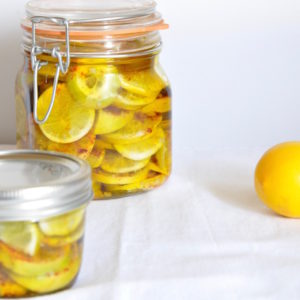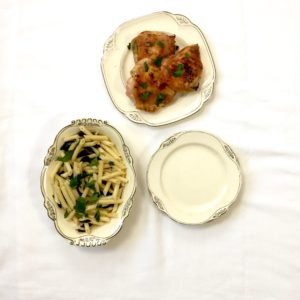The NorCal Half Chicken
Sorry to vanish this week. The IK, or more accurately, the IK’s inhabitant, spent some unexpected time at her doctor’s office, where she learned postural orthostatic tachychardia syndrome is about far more than heat intolerance. It is suspected the IK’s inhabitant will live. She is grateful to her physician, and for having health care at a time so many do not.
So, our Norcal Half Chicken. It is, admittedly, quite close chicken without a recipe. But they are just different enough in technique, and result, to merit discussion. And frankly, that recipe appeared early in the IK’s life. Maybe you weren’t here yet.
Why half? Because sometimes a whole chicken is just too much. And at those times, much as we adore dark meat in this house, it’s nice to split a chicken breast, or share a leg. We each love the wing, so it gets divided.
And how is this bird halved? I use a strong kitchen scissors. This is one piece of kitchen equipment that is truly worthwhile. Mine, a $70 Henckels, sees action in the kitchen and out. Like for impromptu bang trims, much to my hairdresser’s consternation.

Cutting a bird in half is easier than you might imagine. Just shear right up the breastbone. Then flip the bird over, wash your hands and the scissors, and cut alongside the bird’s backbone. Be careful, as the jagged edges of bone can be sharp.

Many cooks advise cutting out the backbone and saving it for stock. These cooks aren’t wrong. But over time I’ve gone from a boneless, skinless, white meat only kinda gal to the woman who reaches for the boniest, scrappiest parts of the bird: neck and wings, backs and feet. And I’m fighting for those parts with John. When we went out for dim sum last weekend, the waitress brought a steaming tray of chicken feet to our table. Our friends had just texted: they were parking. So we had decided to stop being polite and gotten down to business. People, we were eating.
“Chicken feet?” She singsonged.
“Yes, please,” We sang back in unison.
She gaped at us, clearly thinking we’d misunderstood her.
“It’s chicken feet,” she repeated, speaking slowly for our stupid benefit.
“Yes, chicken feet, please!”
This is a roundabout way of saying I do not cut out the backbone here, because as an inveterate canner, my freezer is constantly filled with chicken bones. I don’t need more. And I do love chicken backs.
Cleanliness is important when working with raw poultry. Wash your hands with hot soapy water. If using dish towels, use clean, dry towels for washing and drying your hands, implements, and boards. Be sure to wipe countertops and sinks, too. A halved lemon is an excellent natural sterilizer.
Cleanliness concerns are less worrisome if you use the best quality chicken possible. Buy organic if you can; kosher birds are the next best thing. If you live in California, Mary’s Poultry is peerless.
Given how little we’re doing to this bird, an excellent chicken helps in the taste department, too.
So, that other chicken half. If you are cooking for more than two or three people, by all means, cook it. If not, slide it into a Ziploc bag, label it, and freeze it for your next moment of half-chicken need. Believe me, it’ll come sooner than you think.

This is as good a spot as any to tell you buying whole chickens is cheapest. A woman with two college degrees, and I only grasped the economics of whole chickens around two years ago. Then again, my degrees are in the Humanities. This is not fodder for the “Humanities are worthless argument.” In order to comprehend economics of whole chickens, I needed to be able to read.
Mic drop.
(Likely the only time I will ever be able to use this piece of slang.)
This is truly one of our go-to meals. Although the chicken benefits from presalting–24 hours is ideal–I’ve done everything from an hour to four hours to nothing at all, sliding the chicken into the oven at the last moment. It’s always good. We like to stuff salad leaves, scallions, sliced radishes, and tomatoes into a tortilla, jam in some chicken, and make messy taco constructions. I like a generous dollop of sour cream or sometimes some Amora mustard.

This is also good as a salad: tear the chicken into big pieces, lay them over salad greens, and dress the whole thing with the chicken pan juices and some lemon.

I’ve cooked the chicken in a 12-inch oven-safe frying pan, a plain baker, and Corning Ware. You can either trim the wingtip, or, if you are lazy like me, wrap it in foil to prevent burning.
The vegetables below are suggestions. Use what you love.
The NorCal Half Chicken
Yield: 2-3 servings
prep time: cooking time: 1 hour
optional presalting time: 1-24 hours
One 3-4 pound whole chicken, ideally organic
salt and pepper
a splash of olive oil
Raw vegetables of your choice: 4-8 ounces per diner, according to appetite
salad greens
radishes, cleaned and sliced
tomatoes, sliced
scallions, sliced
lemon wedges
sour cream
strong mustard
tortillas
Be sure to wash your hands, implements, and boards with warm soapy water.
Halve the chicken with sturdy poultry shears or a strong, sharp scissors by slicing first along the breastbone. Flip the bird over. I like to wash my hands and the scissors before slicing along the backbone; I think it is safer. If you agree, wash your hands and scissors with hot, soapy water. Dry well with a clean dishtowel.
Slice chicken alongside backbone, being careful of sharp bones.
If your bird comes with gizzard, neck, heart, you can freeze these for broth. Liver, which is highly perishable, will make broth bitter. Freeze or cook immediately by sautéeing in a little butter or olive oil.
Freeze half of chicken you are not using in Ziploc. Be sure to label and date it. You could also cook it in this recipe.
If you are pre-salting the chicken, place in a pan, and salt it front and back with about 1 teaspoon salt. Note that fine sea salt is much saltier than larger-crystal salts like Diamond Kosher; I learned this the hard way. Add about 1 teaspoon freshly ground black pepper. Leave 1-24 hours if you can, refrigerated, skin side up. If you leave chicken uncovered, skin will dry out and crisp nicely while cooking.
Take chicken out of refrigerator one hour before cooking. Preheat oven to 375F.
Place chicken in a baking pan that just holds it, or a 12-inch oven-safe sauté pan. Wrap wingtip in foil or trim it to prevent burning.
Add small splash of olive oil to pan–no more than 1/2 tablespoon. Chicken will give off plenty of fat as it cooks.
Slide into heated oven and cook for an hour. Chicken is ready when leg moves easily, and juices run clear rather than pink. Knife cuts in leg should reveal cooked flesh without any pink.
Serve with tortillas, a platter of salad greens, sliced tomatoes, radishes, sliced scallions, lemon wedges, sour cream, or sharp mustard. Pour the pan juices into a jug and bring to the table for diners.





